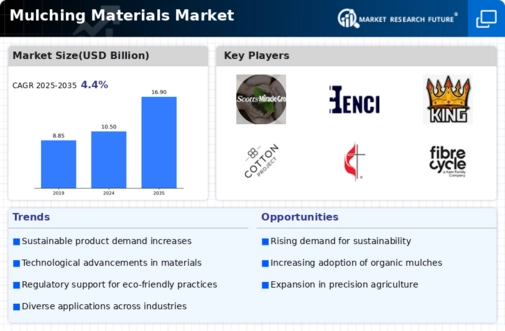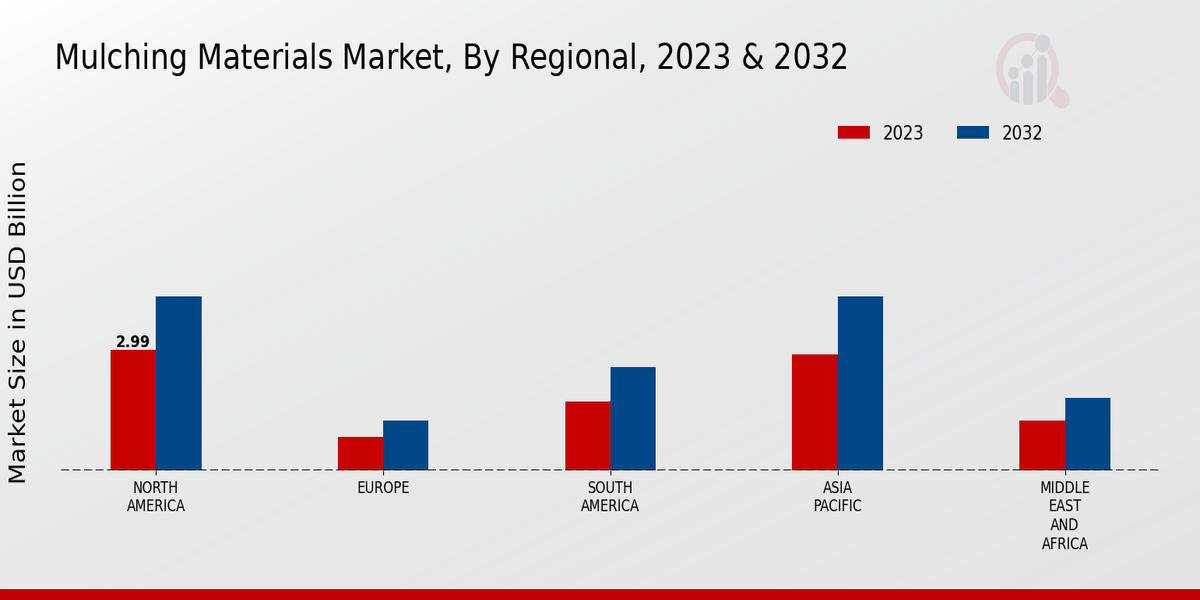Government Initiatives and Support
Government policies and initiatives aimed at promoting sustainable agricultural practices are significantly influencing the Global Mulching Materials Market Industry. Various countries are implementing subsidies and incentives for farmers who utilize eco-friendly mulching materials, thereby encouraging adoption. For instance, initiatives that support the use of organic mulches or recycled materials are becoming more prevalent. This governmental support not only boosts market growth but also aligns with global sustainability goals. As a result, the market is expected to expand, potentially reaching 16.9 USD Billion by 2035, as more farmers take advantage of these programs.
Increased Awareness of Soil Health
There is a growing awareness among farmers and agricultural stakeholders regarding the importance of soil health, which is driving the Global Mulching Materials Market Industry. Mulching is recognized as a vital practice for maintaining soil structure, fertility, and biodiversity. As educational programs and resources become more accessible, farmers are increasingly adopting mulching techniques to enhance soil quality and crop productivity. This trend is likely to contribute to the market's growth, as improved soil health directly correlates with higher yields and sustainable farming practices, further solidifying the role of mulching in modern agriculture.
Market Trends and Growth Projections
The Global Mulching Materials Market Industry is poised for substantial growth, with projections indicating a market value of 10.5 USD Billion in 2024 and an anticipated increase to 16.9 USD Billion by 2035. This growth trajectory suggests a compound annual growth rate of 4.41% from 2025 to 2035. The market trends reflect a broader shift towards sustainable agricultural practices, technological innovations, and increased awareness of soil health. As these factors converge, the industry is likely to witness significant developments, positioning mulching materials as a crucial component in modern agriculture.
Diverse Applications Across Various Crops
The versatility of mulching materials across different crop types is a key driver for the Global Mulching Materials Market Industry. Mulching is applicable to a wide range of crops, including fruits, vegetables, and ornamental plants, making it an attractive option for diverse agricultural operations. This adaptability allows farmers to tailor their mulching strategies to specific crop needs, enhancing productivity and resource efficiency. As the demand for diverse agricultural products continues to rise, the market for mulching materials is expected to expand, reflecting the growing recognition of their benefits in various crop production systems.
Rising Demand for Sustainable Agriculture
The Global Mulching Materials Market Industry is experiencing a notable increase in demand driven by the agricultural sector's shift towards sustainable practices. Farmers are increasingly adopting mulching materials to enhance soil health, conserve moisture, and suppress weeds, which aligns with environmentally friendly farming methods. In 2024, the market is projected to reach 10.5 USD Billion, reflecting a growing awareness of sustainable agriculture's benefits. This trend is likely to continue, as more regions implement policies promoting sustainable farming, thereby potentially increasing the market's value significantly over the next decade.
Technological Advancements in Mulching Techniques
Innovations in mulching technologies are propelling the Global Mulching Materials Market Industry forward. Advanced materials, such as biodegradable films and smart mulching systems, are being developed to improve efficiency and effectiveness in crop production. These technologies not only enhance crop yield but also reduce environmental impact, making them appealing to modern farmers. As these advancements gain traction, they are expected to contribute to the market's growth, with projections indicating a compound annual growth rate of 4.41% from 2025 to 2035. This growth reflects the industry's adaptation to technological changes and evolving agricultural practices.









